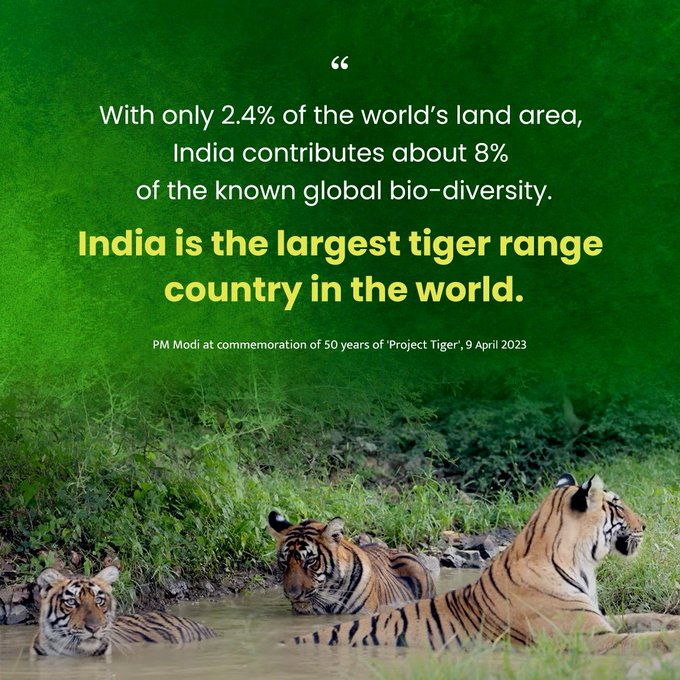Declares tiger numbers at 3167
India is home to 75% of the world’s tiger population in the 75th year of Indian independence. It is also a coincidence, the Prime Minister continued, that the tiger reserves in India cover 75,000 square kilometers of land and in the past ten to twelve years, the tiger population in the country has increased by 75 percent.
“India does not believe in the conflict between ecology and economy, and gives equal importance to the coexistence of both”, the Prime Minister remarked. Recalling the importance of tigers in the history of India, the Prime Minister mentioned that graphical representations of tigers were found on the ten-thousand-year-old rock art in Madhya Pradesh. He also added that the Bharia community from Central India and Worli community from Maharashtra among others worship the tiger whereas many communities in India consider the tiger as a friend and brother. He further added that Maa Durga and Lord Aiyappa ride the tiger.
- India has only 2.4 percent of the world’s land area but it contributes toward 8 percent to known global biodiversity.
- India is the largest tiger range country in the world,
- the largest Asiatic elephant range country in the world with nearly thirty thousand elephants, and also
- the largest single-horn rhino country with a population of nearly three thousand.
- India is the only country in the world to have Asiatic lions and its population has increased from around 525 in 2015 to around 675 in 2020.
- He also touched upon India’s leopard population and stated that it increased by over 60 percent in 4 years.
What is Project Tiger?
Project Tiger, an ongoing Centrally Sponsored Scheme, was launched by the Government of India on 1 April 1973 in nine reserves of different States Assam, Bihar, Karnataka, Madhya Pradesh, Maharashtra, Odisha, Rajasthan, Uttar Pradesh and West Bengal over an area of approximately 14,000 sq. km.
The country aims to sustain a viable tiger population based on a scientifically calculated carrying capacity of habitats while maintaining a balance between development and wildlife conservation.
country added 11 wetlands to its list of Ramsar sites taking the total number of Ramsar Sites to 75. He also noted that India added over 2200 square kilometers of forest and tree cover by 2021 when compared to 2019. In the last decade, the Prime Minister said, the number of Community Reserves increased from 43 to over 100 and the number of National Parks and sanctuaries around which Eco-sensitive Zones were notified increased from 9 to 468, that too in a decade.
As per National Tiger Conservation authority (NTCA) website, Tiger is an umbrella species which ensures viable populations of other wild animals (co-predators, prey) and forest, thereby ensuring the ecological viability of the entire area and habitat, which also ensures the water and climate security of the region.
Initially, the project covered nine tiger reserves spread over 18,278 sq km. Now, the project includes 53 tiger reserves sprawling over around 75,000 sq km of the region.
